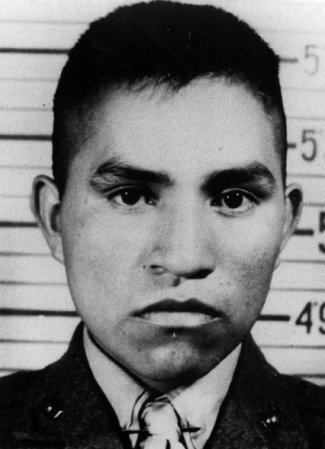Movies about the Marines are usually about one moment in their lives. But many movies, just by their very nature, can only show a small part of the story, and often the most fascinating stuff gets left on the cutting room floor for not being flashy enough or not part of that one moment. That said, much of it deserves its own movie, like these examples:
Pride of the Marines, and Al Schmid
Schmid rose to fame thanks to an act of heroism he barely survived. At Guadalcanal, Schmid was forced to take over as a machine gunner and fought off a Japanese assault, even after he was blinded by a grenade attack, reloading and firing entirely by listening to his captain and by feel, an event we ultimately saw in Pride of the Marines.
More interesting about Schmid, though, was his battle for recovery. Something the movie largely ignored was what manning that gun cost him; he was completely blind and disfigured, to the point where he wanted to hide from the rest of society. But despite that, Schmid rallied and spent the rest of the war promoting war bonds, doing charity appearances, and demonstrating that there’s life after war.
Taking Chance, and Michael Strobl
Strobl is one of the rare Marines who didn’t have to go to war to have a compelling life story. Working at Quantico as an instructor for the FBI during Operation Iraqi Freedom, Strobl volunteered to accompany the remains of a fellow Marine, Chance Phelps, to his final resting place. Along the way, he shared his thoughts about service and the meaning behind Semper Fi, the famous motto of the Marine Corps. It ultimately became the acclaimed drama Taking Chance. Since the movie, though, Strobl’s kept up with the community service.
Apollo 13, and Fred Haise
Fred Haise’s space flight was dramatically depicted in Apollo 13. But, by necessity, there was a lot about Haise the movie left out.
He actually got his start as a fighter pilot for the Marine Corps, despite the fact that he admitted he was originally scared of flying and was angling for a career as a journalist. Haise’ jet experience served him well; he signed on for NASA right as the program was founded working as a civilian research pilot, and served again as a fighter pilot during the Berlin Crisis of 1961.
And, after the Apollo 13 crisis, Haise, who might be forgiven for never wanting to see space again, helped test the shuttle Enterprise. Even after he retired, he’s never stopped working to put us into space, working as a fellow in the American Astronautical Society and using his experience to motivate the next generation of astronauts.
Ira Hayes

Finally, there’s Ira Hayes, a Native American Marine who might just be the most filmed and written about Marine in Hollywood history. Hayes was one of the original flag-raisers on Iwo Jima, likely one of the single most famous photographs ever taken, and that alone probably would have made him famous.
What often gets missed about Hayes, though, is that he fought, hard, to make sure the other men in the picture got the credit they deserved, and that everyone, from the African-American Marines to the actual men in the photograph he was a part of, was honored. In fact, Hayes traveled more than a thousand miles, walking and hitchhiking, just to personally confirm the identity of one of those men to his family. Hayes struggled with his fame and the men who didn’t come back, but no matter what, he made sure those men were remembered.






